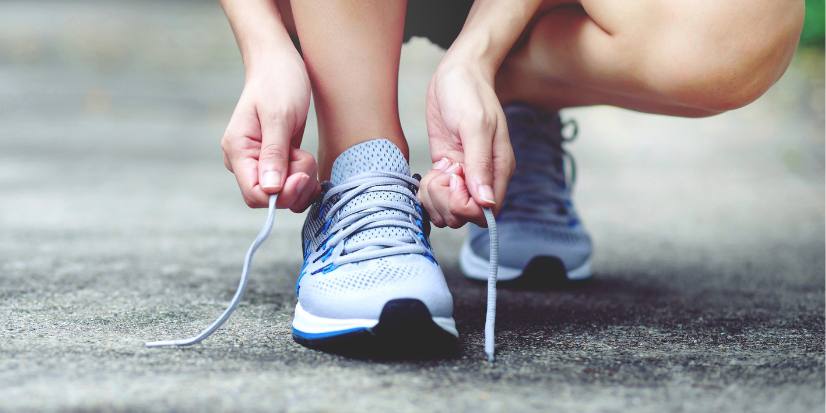Proper Shoe Gear is Essential for Healthy Living
- Posted On:

The human foot consists of 28 bones and 33 joints and is one of the most complex structures in the human body. During daily living, we ask a great deal of our feet:
- Supporting our body weight
- Providing movement of the body
- Being our platform for standing
- Shock absorber when walking / running
- Lever to propel the body forwarding during stepping
Overall, our feet consist of many moving parts and muscles to power our everyday movement, and it is crucial to maintain the health of our feet.
Why Proper Shoe Gear
One way to help keep our feet healthy is to make sure we are purchasing the right type of footwear. Proper shoe gear provides necessary protection and support, can enhance performance, and be a fashion staple. Many people suffer from foot pain, and much of it has to do with improper shoe gear. However, with so many shoes on the market, how can you possibly pick the right pair that fits your needs? Let us dive into how to choose the proper shoe gear. When looking at any type of footwear, consider the following aspects:
- Purpose
- Fit
- Material
- Support
Purpose
It is important to select the appropriate footwear depending on the activity you will be engaging in. For example, running shoes have more cushioning and support than walking shoes. Dress shoes have a different design and fit than hiking shoes. Some questions to ask yourself when looking for a new pair of shoes could include:
- Do you need it for exercise?
- Do you need it for working on your feet all day?
- Do you need it for vacationing to the beach?
Likely one pair of shoes will not serve all purposes, but you may find a pair that serves many of them.
Fit for Foot Type
The next consideration should be your foot type:
- Do you have a high arch or a flat arch?
- Do you have a wide or narrow foot?
The way a shoe fits is very important to overall function and comfort. Ill-fitting shoes, whether too tight or too loose, can lead to discomfort and foot issues. It is vital to ensure that your shoes fit properly and allow ample space for your toes to move comfortably. Aim for at least a thumb's width of space between your longest toe and the shoe's end. For the best fit, measure your feet at the end of the day when they are largest, and try on shoes later in the day. Remember to bring along the socks or hose you intend to wear with the shoes when trying them on at the store.
Material
You also will need to make sure that the fabric of your shoe is not too stiff to be putting pressure on your toes. This can cause painful blisters, calluses, or even open sores. Choosing the proper material will also help with the durability of the shoes when using them for a specific activity. For example, for the gym, shoes that are lightweight, breathable mesh upper portion, a midsole with arch support and a rubber sole would be best. While if you plan to be exercising outdoors, making sure your footwear is waterproof is very important due to the weather / elements.
Support
The shoes you choose can influence more than just your feet; they can affect your entire body's alignment. Wearing footwear that offers the correct amount of support can help evenly distribute your body weight, lessening pressure on your joints, especially your ankles, knees, hips, and lower back. This alignment can enhance your posture, and lower the likelihood of musculoskeletal problems like plantar fasciitis and back pain.
Dr. Hannah Johnk’s, Myrtue's Podiatrist, Recommendations
There are a few types of shoes that I recommend avoiding:
- While shoes with a pointed toe and a high heel may look nice, they are contorting your foot into a very unnatural position and can cause serious deformity down the road.
- Shoes with gimmicks such as rocker bottoms, foam insoles, or springs in the heels are usually not all they are hyped up to be. They tend to feel good at first but do not stand up to wear.
- Avoid backless shoes. Our walking pattern changes when wearing these, as we have to curl our toes to keep the shoes on. This can lead to both short and long-term problems.
In general, if you are going to be walking or standing on your feet for an extended period, I recommend a supportive pair of shoes, especially if you will be on a hard or uneven surface. The two main characteristics of a supportive shoe are a stable midsole and a reinforced heel counter. The shoe should not be able to bend or fold in half.
Children’s Shoe Gear Recommendations from Dr. Hannah Johnk
I do not usually recommend a stiff-soled shoe for children. Their feet are still developing, and movement is essential to that development. Their feet need to feel the ground and sense position changes in order to strengthen and grow properly. The development of children’s feet can also benefit greatly from some time spent barefoot on a natural surface, such as outside in the yard. This provides incredible sensory input that helps with balance, coordination, and strength.
In conclusion, wearing the right footwear ensures that your entire body receives adequate support, promoting overall health and well-being. While Dr. Johnk does not recommend one specific brand over another, many of them do offer supportive options. During an appointment, Dr. Johnk is able to discuss your specific foot type, make specific recommendations, and discuss further concerns you may have that regard your feet.
If you would like to discuss feet health or have additional questions, you may schedule an appointment with Dr. Johnk at Myrtue’s Harlan Clinic by calling 712.755.4516.

